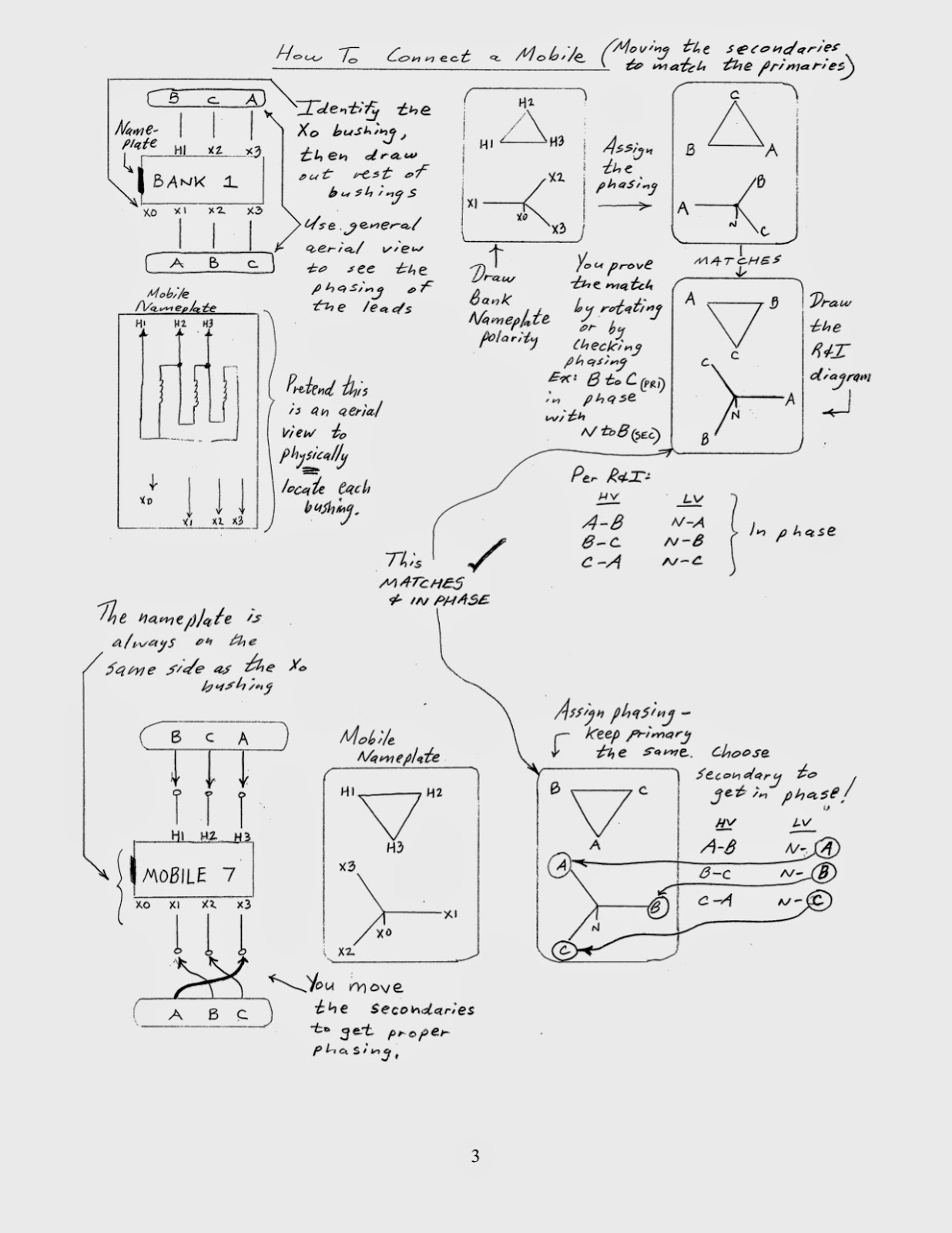 |
| photo: www.energy-parts.com |
In this example, Cat-Trac has a 115kV bus with two transmission lines connected to it. Each line breaker has bushing current transformers (CT) and the bus has a potential three phase transformer (PT), both of which provide secondary inputs to relaying and metering. Breaker 98712 was replaced, therefore, breaker 97112 was used as the reference, for purpose of calculating current magnitudes and phase angle for breaker 98712. Work was scheduled in accordance with PJM. This system utilizes A-B-C rotation. A balanced three phase system was assumed. Voltage and current magnitudes are in RMS.
The phase angle is the angular difference between voltage and current and it is based off of the real and reactive power flows. Since breaker 97112 showed .7 megawatts (MW) and 8.3 megavars (MX) flowing into the bus, breaker 98712 should have the same readings but both flowing away from the bus. Using basic power formulas, the phase angle was shown to be 85 degrees. The angle is considered lagging because the MW's and MX's are in the same direction. On a distribution and transmission system, it is accepted that inductive reactive power will flow in the same direction as real power. Capactive reactive power would flow opposite to real power.
Using basic power formulas and a reference line-to-line voltage reading, taken from a voltage meter from the bus potential transformer, primary amps was calculated to be 41.5 line amps (A). CT secondary current was calculated to be .17A, using the CT's ratio of 240, which is a ratio number of primary amps to secondary amps.
It helps to draw current vectors on a power quadrant graph. You simply pick the quadrant you need to be in, based on what the real and reactive power flows are. Because current vectors rotate counter clockwise, it is important to draw the graph so that negative MX's are on the positive vertical axis and positive MX's are on the negative vertical axis. First Energy standard is that power that flows away from the substation is considered positive and vice versa for flows that come into a substation. Therefore, since both real and reactive power flowed away from the substation in this example, the first current vector is drawn in quadrant two with an angular difference from the horizontal axis. If positive real power and negative reactive power flow was observed, then the current vector would have been drawn in quadrant one. Negative real and positive reactive would have been quadrant three. Negative real and negative reactive would have been quadrant four.
Because a three phase potential transformer was used for the voltage readings, A phase is considered the reference. A reference vector is typically drawn at zero degrees. Therefore, you can imagine this voltage reference located at zero degrees on the power quadrant graph. The first vector drawn in quadrant two in the picture shown means that A phase current vector lags A phase voltage vector by 85 degrees. Once this first current vector is drawn, then it easy to draw the other vectors to show 120 degree displacement and A-B-C counter-clockwise rotation.
When the breaker was put into service, current vectors were read from a SEL-411 relay and drawn on a graph. A phase current was shown as 86 degrees lagging, which is very close to the calculation. You will also notice an imbalance in the current magnitudes. There will always be some imbalance but it is very important to verify the correct phase angle and phase rotation, so that when readings are telemetered to transmission control centers, the operators there know the correct direction that real and reactive power is flowing.
Article by Dan Scrobe III
It helps to draw current vectors on a power quadrant graph. You simply pick the quadrant you need to be in, based on what the real and reactive power flows are. Because current vectors rotate counter clockwise, it is important to draw the graph so that negative MX's are on the positive vertical axis and positive MX's are on the negative vertical axis. First Energy standard is that power that flows away from the substation is considered positive and vice versa for flows that come into a substation. Therefore, since both real and reactive power flowed away from the substation in this example, the first current vector is drawn in quadrant two with an angular difference from the horizontal axis. If positive real power and negative reactive power flow was observed, then the current vector would have been drawn in quadrant one. Negative real and positive reactive would have been quadrant three. Negative real and negative reactive would have been quadrant four.
Because a three phase potential transformer was used for the voltage readings, A phase is considered the reference. A reference vector is typically drawn at zero degrees. Therefore, you can imagine this voltage reference located at zero degrees on the power quadrant graph. The first vector drawn in quadrant two in the picture shown means that A phase current vector lags A phase voltage vector by 85 degrees. Once this first current vector is drawn, then it easy to draw the other vectors to show 120 degree displacement and A-B-C counter-clockwise rotation.
When the breaker was put into service, current vectors were read from a SEL-411 relay and drawn on a graph. A phase current was shown as 86 degrees lagging, which is very close to the calculation. You will also notice an imbalance in the current magnitudes. There will always be some imbalance but it is very important to verify the correct phase angle and phase rotation, so that when readings are telemetered to transmission control centers, the operators there know the correct direction that real and reactive power is flowing.
Article by Dan Scrobe III






